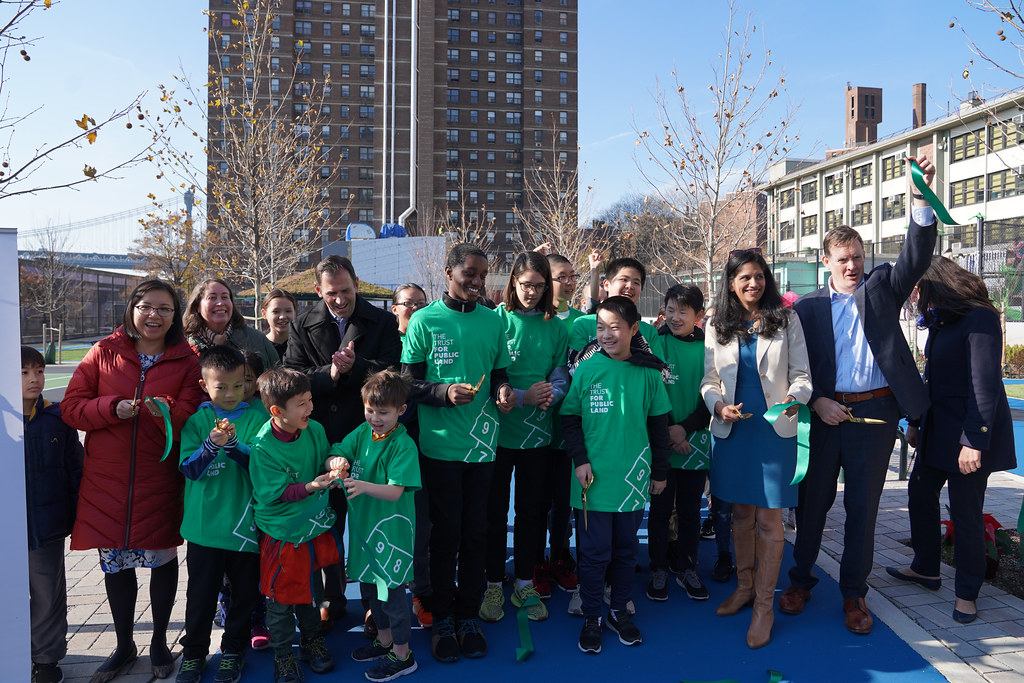Student-Designed Resilient "Green" Playground at P.S. 184 in Chinatown Will Improve The Health Of The East River
November 25, 2019
Green Infrastructure Will Capture 1.3 Million Gallons of Stormwater Each Year and bring 26,000 Residents Within a 10-Minute Walk of a Park
Photos are Available on DEP’s Flickr page
The New York City Department of Environmental Protection (DEP) on Monday joined City Council Member Margaret Chin, the Trust for Public Land, students and teachers to cut the ribbon on a new, student-designed green playground at P.S. 184M in Manhattan’s Chinatown. The playground, which will help increase resiliency, reduce flooding and improve the environment, was built in partnership with the Mayor’s Office of Resiliency. DEP provided $615,000 for the installation of green infrastructure design elements to help improve the health of the East River. The $1.7 million playground will also provide 26,496 Chinatown residents with green space within a 10-minute walk of home.
“Congratulations to The Trust for Public Land and the entire P.S. 184M community, particularly the student designers, for creating a beautiful and environmentally-friendly school playground,” said DEP Commissioner Vincent Sapienza. “The green infrastructure elements installed in this amazing new play space will absorb the rain and snow that falls on it and help to improve the health of the East River.”
The playground’s green infrastructure, a hallmark of The Trust for Public Land’s partnership with DEP, will annually capture 1.3 million gallons of stormwater runoff that would have otherwise flooded the surrounding streets and overwhelmed the sewer system, allowing untreated water to rush into the East River. Each green playground also includes 20-30 new trees that bring shade and better air quality to their neighborhoods. Similar playgrounds are being designed in the Bronx River, Newtown Creek and Flushing Bay watersheds.
“Parks and green playgrounds play a vital role in helping to combat the effects of climate change in cities, while also providing places for communities to gather and enjoy the outdoors,&rqdquo; said Carter Strickland, New York State Director for The Trust for Public Land. “Green infrastructure such as trees, gardens and infiltration areas under turf absorb rainfall and stormwater during a storm surge. This new playground will be a critical element of the City’s fortification of Lower Manhattan against flooding, as well as provide a place for the Chinatown community to engage in healthy recreation and socialize with neighbors.”
“There’s far more to this playground than meets the eye,” said Jainey Bavishi, Director of the Mayor’s Office of Resiliency. “By leveraging the power of resilient design, it will prevent flooding and create a sanctuary against rising temperatures while also providing new and improved recreational space for students and the surrounding community.”
“The wave of climate strikes and protests we’re seeing across the country proves that our young people can–and must–drive the dialogue on climate action. This project shows exactly what you can achieve when our youth are at the leadership table,” said Council Member Margaret S. Chin. “Designed by students, P.S. 184M’s new playground will be an incredible amenity for community members across generations, and serves as an innovative model for green infrastructure and stormwater protections. I thank the Department of Environmental Protection, the Trust for Public Land and the Mayor’s Office of Resiliency for your work to invest in resiliency, open space, and youth leadership in Two Bridges and Chinatown.”
Funding for the playground was also secured by the Mayor’s Office of Resiliency through HUD’s Community Development Block Grant National Disaster Resilience competition. The green playground will complement the City’s ongoing Lower Manhattan Coastal Resiliency (LMCR) project, which will adapt the Lower Manhattan area to the long-term impacts of climate change.
The completed P.S. 184M playground features basketball courts, play equipment, student artwork, an outdoor classroom, yoga circle, stage, tennis court, and turf field. The playground’s green infrastructure elements include an infiltration basin under the turf field, a green roof gazebo, a garden for student use, and several species of trees including elm, zelkova, and sycamore.
Since 1996, working with the City, The Trust for Public Land’s NYC Playgrounds Program has designed and/or built more than 200 school and community playgrounds across the five boroughs. In addition to serving students, all playgrounds in New York City are open to the public on weekends, after school, and during school breaks, providing opportunities for both children and adults to be physically active. The program has added more than 160 acres of additional playground space serving the nearly 4 million people who live within a 10-minute walk of one of the sites.
About New York City DEP
DEP manages New York City’s water supply, providing approximately 1 billion gallons of high-quality drinking water each day to more than 9.6 million residents, including 8.6 million in New York City. The water is delivered from a watershed that extends more than 125 miles from the city, comprising 19 reservoirs and three controlled lakes. Approximately 7,000 miles of water mains, tunnels and aqueducts bring water to homes and businesses throughout the five boroughs, and 7,500 miles of sewer lines and 96 pump stations take wastewater to 14 in-city treatment plants. DEP has nearly 6,000 employees, including almost 1,000 in the upstate watershed. In addition, DEP has a robust capital program, with a planned $20.1 billion in investments over the next 10 years that will create up to 3,000 construction-related jobs per year. For more information, visit nyc.gov/dep, like us on Facebook, or follow us on Twitter.
About The Trust for Public Land
The Trust for Public Land creates parks and protects land for people, ensuring healthy, livable communities for generations to come. Nearly ten million people live within a ten-minute walk of a Trust for Public Land park, garden, or natural area, and millions more visit these sites every year. To support The Trust for Public Land and share why nature matters to you, visit www.tpl.org.





